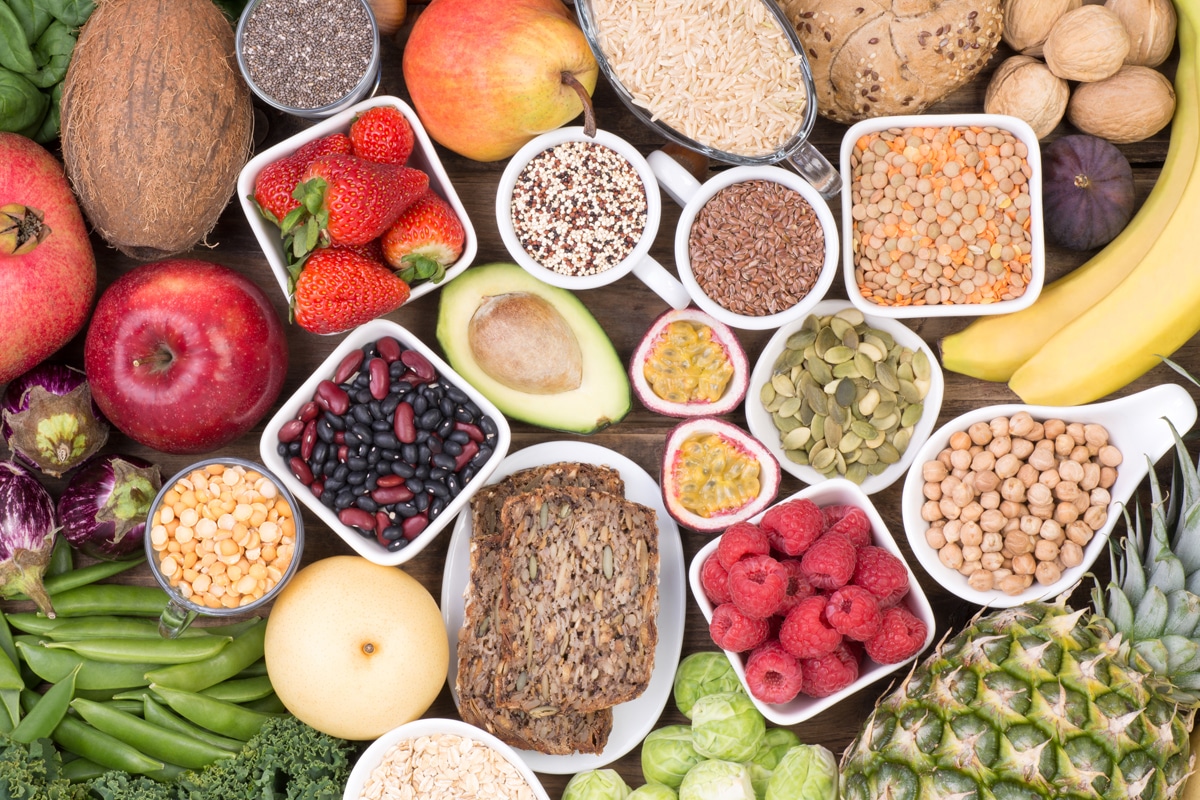
Looking for a list of the highest fiber foods that are actually enjoyable to eat? You’re in the right place.
As a registered dietitian, and as someone who has experienced the not-so-glamorous side effects of pregnancy-related constipation, I know firsthand how much of a difference the right balance of fiber can make. It’s one of the most essential tools for gut health, energy, and overall well-being.
When I was pregnant, the only thing more regular than my OB appointments was my morning fiber ritual: a bowl of oats topped with a heaping tablespoon of flax meal, a handful of crunchy walnuts, juicy berries, and a 16 oz glass of water. That combo kept things moving. And that, my friend, is a lifesaver during pregnancy.
One of my private clients was dealing with the all-too-common pregnancy double whammy: constipation and hemorrhoids. I’m talking about painful, terrifying, “please don’t make me push” hemorrhoids.
We eased her into a new routine: oats every morning, legumes four times a week, swapping less complex carbohydrates for whole grains, and doubling her veggie portions. We also made sure she got a balance of soluble and insoluble fiber (yes, both matter!) and gradually upped her water intake to help fiber actually do its job. Within weeks, she was regular.
Why does fiber matter so much?
Fiber supports your gut health, keeps your blood sugar steady, helps you feel full, and yes, makes pooping way less traumatic. Fiber needs water to work properly, and your body needs fiber to feel like itself again.
If your pantry is low on fiber, I’ve got the fix. Let’s stock your kitchen with the highest fiber content foods around.
What Is Dietary Fiber?
Fiber is a type of carbohydrate that your body can’t digest. It moves through your digestive tract, helping to clear out waste, regulate digestion, and support a healthy gut environment.

Soluble vs. Insoluble Fiber: Know the Difference
There are two main types of fiber and you need both to keep things running smoothly.
- Soluble fiber dissolves in water and forms a gel-like substance in your gut. It slows digestion, helps regulate blood sugar, and lowers cholesterol. Some of the most popular options are oats, apples, chia seeds, and lentils.
- Insoluble fiber doesn’t dissolve. It adds bulk to your stool and keeps things moving through your intestines like nature intended. You’ll find it in veggies, whole grains, and things like bran.
In my practice, I’ve seen too many people focus on just one type, usually soluble, because they’re scared of feeling bloated or gassy. When your fiber is balanced, your body thanks you.
So What Does Fiber Actually Do for You?
When you’re consuming the right amount of fiber, it:
- Keeps your digestion regular (translation: less time on the toilet, more time living your life).
- Stabilizes blood sugar so you don’t crash at 3 p.m.
- Helps you feel full, so you’re not constantly rummaging through the pantry.
- Supports a healthy gut microbiome that does so much for your immune system and mood.
- Reduces the risk of heart disease, Type 2 diabetes, and colon cancer.
Fiber Intake: How Much Daily Fiber Do You Need?
Let’s talk numbers. According to the USDA and Mayo Clinic, here’s how much daily fiber content you should aim for to support your health:
- Women under 50: 25 grams per day
- Men under 50: 38 grams per day
- Women over 50: 21 grams per day
- Men over 50: 30 grams per day
- Pregnant women: At least 28 grams per day
Most Americans aren’t even coming close to the recommendations.
On average, we’re getting around 15 grams of fiber a day. That’s well below the recommended amount, and your body feels the difference. Constipation, cravings, energy crashes, blood sugar swings, mood dips… low fiber plays a bigger role in those areas than you might think.
Pregnancy Calls for Even More
Pregnancy isn’t a time to skimp on fiber. In fact, it’s a time in your life where you really need to step it up. Between the increased iron from prenatal vitamins (which can slow digestion) and a growing uterus pressing on your bowels, regularity becomes a full-time job. Add hemorrhoids into the mix, and let’s just say: high fiber foods are not optional.
I always tell my pregnant clients, fiber is about comfort, blood sugar stability, and supporting your body during pregnancy.

Other Reasons You May Need More Fiber
Some people need more than the baseline:
- If you’re managing diabetes or prediabetes, fiber helps blunt blood sugar spikes.
- If you’re looking to lose weight, fiber helps with satiety and helps curb cravings.
- If you’re over 50, higher fiber can help reduce the risk of colon cancer and keep digestion running smoothly.
Bottom line? Most people need to eat more fiber.
Pantry Staples with the Most Fiber Per Serving
If you want to increase the amount of fiber you’re eating without doing a total kitchen overhaul, start with your pantry. Dry goods and shelf-stable ingredients are some of the easiest ways to keep fiber on hand and ready to go.
These are my go-to staples that I use every week when I’m meal prepping, throwing together salads, or blending up post-workout smoothies.
- Chia seeds (about 10 grams of fiber per 2 tablespoons): Great for overnight oats, smoothies, or making quick chia pudding. A fiber-rich powerhouse with a bonus boost of omega-3s.
- Flax meal (around 3 grams of fiber per tablespoon): Adds fiber, texture, and a nutty flavor to oats, smoothies, and baked goods. I like to mix a spoonful into my oats for breakfast.
- Almond flour (3 grams of fiber per ¼ cup): A great swap for white flour in baking or coatings. You get healthy fats, a good amount of protein, and a decent amount of fiber.
- Bulgur wheat (4.5 grams of fiber per cooked cup): Underrated but incredibly versatile. Use it in salads like tabbouleh or as a grain base for bowls.
- Oats (4 grams of fiber per 1 cup cooked): A classic for a reason. Rich in soluble fiber, oats help with blood sugar regulation and keep you full.
- Lentils (about 15 grams of fiber per cooked cup): Affordable, filling, and incredibly fiber-rich. I recommend cooking up a batch and keeping it in the fridge to add to soups, bowls, or wraps.
- Canned beans (around 6–9 grams of fiber per ½ cup): Look for low-sodium options. I keep organic refried vegetarian beans and garbanzo beans on hand to toss into salads and grain bowls for a soluble fiber boost.
These are my favorite staples. If you’re building a kitchen that supports regular digestion, stable energy, and healthy blood sugar, these pantry items are your foundation.
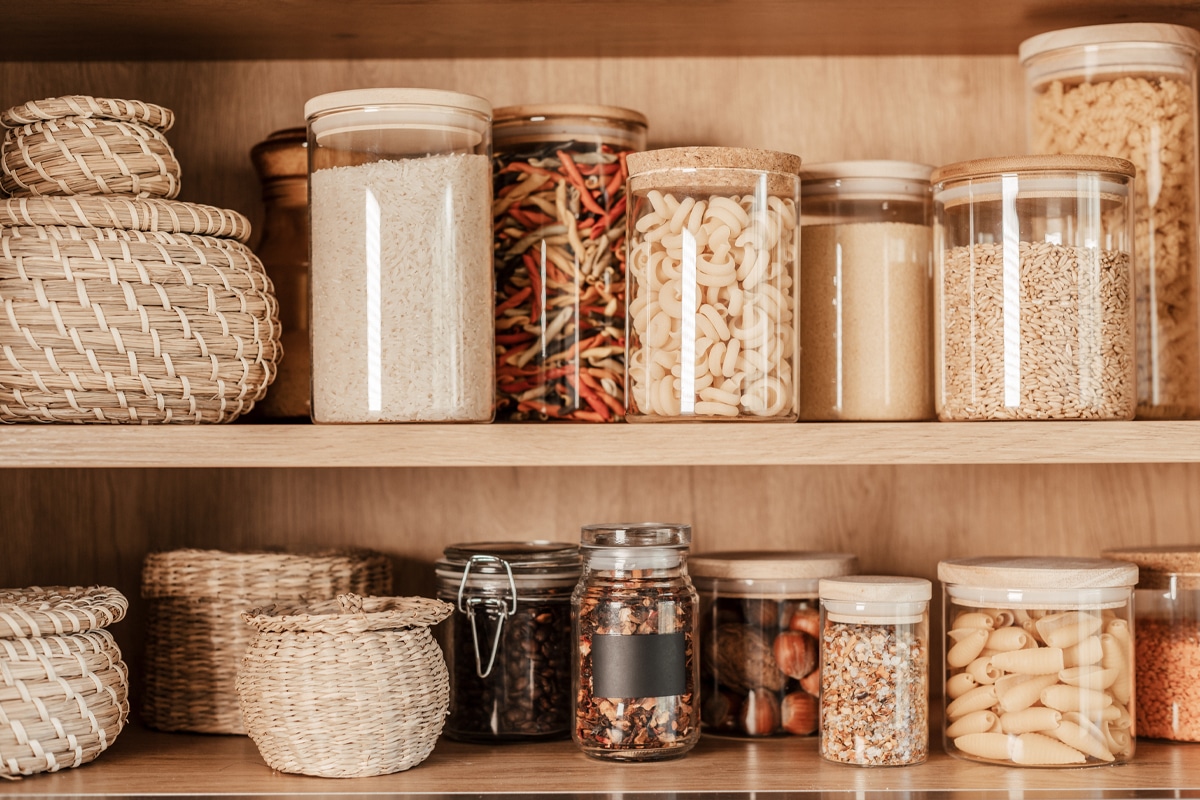
Are Vegetables High in Fiber?
Short answer: yes, but some are pulling more weight than others.
Vegetables are one of the best sources of insoluble fiber, and many pack in a solid dose of vitamins, minerals, and antioxidants at the same time.
If you’re not eating at least a cup of vegetables at lunch and dinner, you’re missing out on an easy opportunity to improve your fiber.
Here are some of the top high-fiber vegetables I regularly recommend:
- Brussels sprouts (about 4 grams per 1 cup cooked): These little cabbages are loaded with fiber, plus vitamin C and K. Roast them to bring out their natural sweetness.
- Broccoli (around 5 grams per cup cooked): A powerhouse for both fiber and antioxidants. Steam it, roast it, or toss it into a stir-fry.
- Artichokes (about 7 grams per medium artichoke): One of the highest fiber veggies out there. If prepping a whole one sounds overwhelming, look for canned or frozen artichoke hearts packed in water.
- Carrots (about 3.5 grams per cup chopped): Crunchy, slightly sweet, and easy to pack raw or cooked. Pair them with hummus for a double fiber hit.
- Spinach (about 4 grams per cup cooked): Raw spinach has less fiber per volume, so cook it down to really get the benefits. Great in soups, sautés, or blended into smoothies.
Getting a variety of vegetables into your meals feeds your gut with the diversity it needs to thrive. If you’re struggling to get enough in, start with one extra cup per day and build from there.

High Fiber Fruits: Nature’s Sweetest Solution
Fruit gets a bad name in some corners of the nutrition world, but let’s be clear: whole fruit is not the enemy.
Many fruits are an excellent source of both soluble and insoluble fiber, plus they’re naturally hydrating and full of antioxidants. If you’ve got a sweet tooth, this is your best swap.
Are Grapes High in Fiber?
Grapes do contain fiber (about 1 gram per cup) but they’re not the best bang for your buck. If you love them, go ahead and enjoy them, but don’t count on grapes alone to meet your fiber goals.
Better Fruit Options for Fiber
Here are some of my top picks for fruits that actually move the needle:
- Raspberries (8 grams per cup): One of the highest fiber fruits out there. Add them to yogurt, oats, or enjoy a handful as a snack.
- Pears with the skin (about 5–6 grams each): Don’t peel them. The skin holds most of the fiber. Try pairing a sliced pear with almond butter for a balanced snack.
- Apples with the skin (about 4 grams each): Another solid choice. Slice them thin and sprinkle with cinnamon, or bake them for a naturally sweet treat.
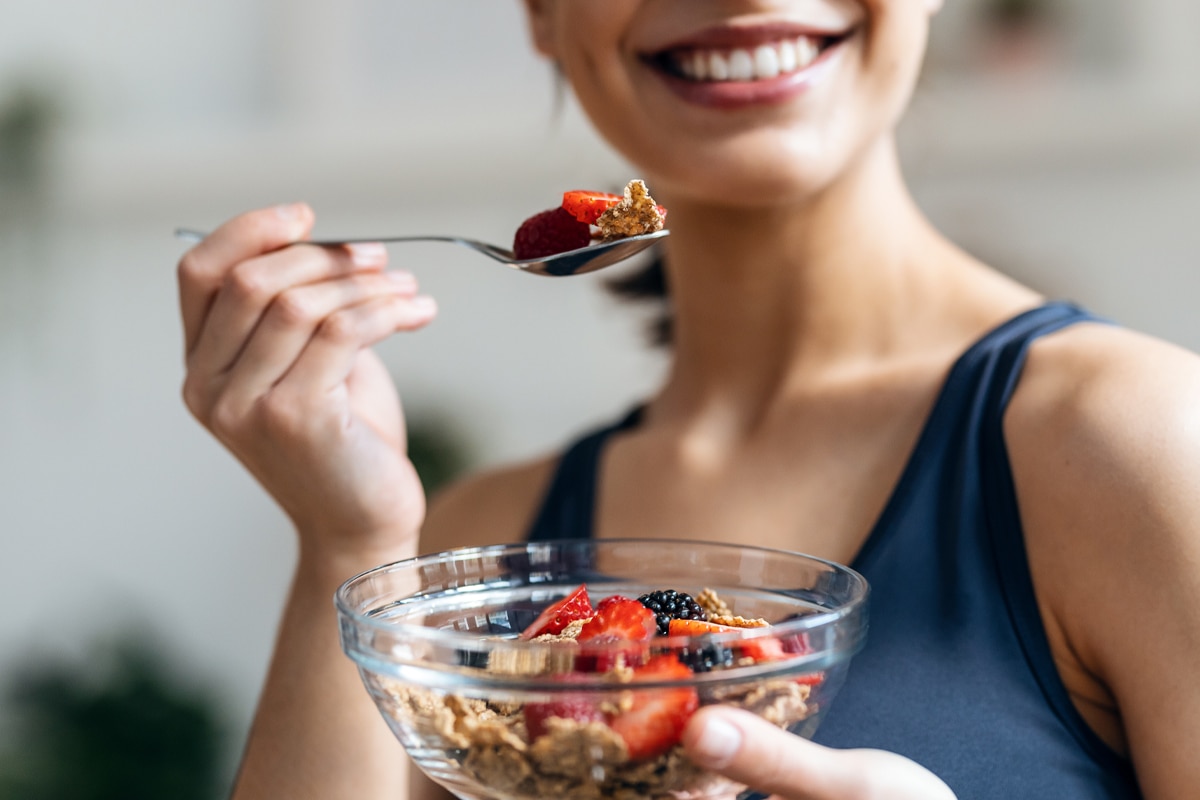
Client Win: The Cookie Swap That Changed Everything
One of my pregnant clients had a habit of reaching for packaged cookies when her afternoon cravings hit.
We made a small but meaningful swap: pear slices with almond butter.
The result?
She still got the crunch and sweetness she craved, but with a satisfying dose of fiber and healthy fat that actually kept her full. After two weeks she had great results.
She was more regular, she had more energy, fewer blood sugar crashes, and no desire to go back to the cookies.
Fruit doesn’t need to be feared. Just choose wisely, eat the peel when it makes sense, and pair it with protein or a healthy fat when you can.
High Fiber Vegan and Plant-Based Favorites
Whether you’re fully plant-based or just trying to eat more fiber without relying on animal products, these foods deliver.
Many vegan staples are naturally high in fiber and packed with nutrients that support digestion, energy, and blood sugar control.
Here are some of the best high-fiber options to lean on:
- Tofu and Tempeh (about 2–5 grams per serving): These soy-based proteins are fiber-light compared to legumes, but still offer some. Tempeh, which is fermented, tends to have a little more fiber and supports gut health in other ways, too.
- Quinoa (5 grams per cooked cup): A complete protein and a solid fiber source. Use it in place of rice for a more balanced meal.
- Edamame (about 4 grams per ½ cup): A protein-packed snack that’s also rich in fiber. Great steamed with a pinch of sea salt or tossed into a salad.
- Chickpeas (around 6–7 grams per ½ cup): Versatile and affordable. I love adding garbanzo beans to my salads to boost the soluble fiber and add texture.
- Sweet Potatoes (about 4 grams per medium potato with skin): Naturally sweet, filling, and packed with fiber.
Looking for more vegan ideas with fiber and flavor? Check out Comfort Food for Vegetarians for warm, satisfying recipes that happen to be plant-based and nourishing.

Voula’s Favorite Vegan Snack
When I want something crunchy and satisfying that also supports my fiber goals, I reach for roasted chickpeas. I toss them with olive oil, sea salt, and smoked paprika, then roast them until crispy. They’re the perfect afternoon snack or salad topper with real staying power.
Plant-based eating doesn’t have to mean boring or bland. With the right fiber-rich ingredients, it can be deeply satisfying and easy on your digestion.
High Fiber Proteins: Yes, They Exist
Protein gets all the attention in the wellness world, but fiber deserves a seat at the same table, especially when they show up together.
Foods that are high in both fiber and protein help you stay full longer, support muscle repair, and keep your digestion humming.
Here are a few of my favorite double-duty foods that pack both nutrients:
- Black beans (about 15 grams of fiber and 15 grams of protein per cooked cup): Budget-friendly and endlessly versatile. Toss them into soups, burrito bowls, or mash them for a quick spread.
- Lentils (about 15 grams of fiber and 18 grams of protein per cooked cup): One of the best plant-based protein sources, and a fiber heavyweight. I recommend them to nearly every client, regardless of diet.
- Quinoa (5 grams fiber and 8 grams protein per cooked cup): A rare plant-based complete protein with fiber to boot. Great as a base for bowls or mixed into salads.
- Chickpeas (around 6–7 grams of fiber and 7 grams of protein per ½ cup): Snackable, blendable, and salad-ready. I use them in everything from roasted snacks to creamy hummus.
- Nuts like almonds or pistachios (around 3 grams of fiber and 6 grams of protein per ounce): A handful goes a long way. Keep portions in check, but these are great as part of a fiber-rich snack.
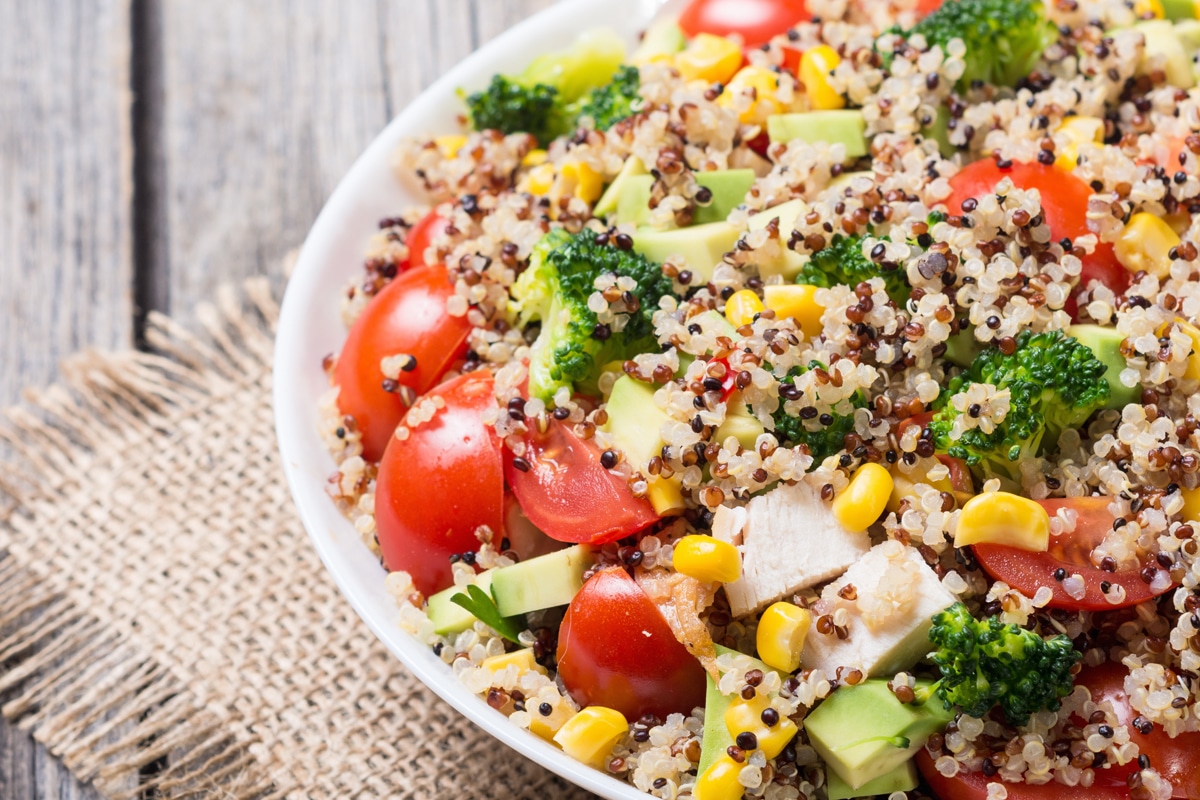
For Plant-Based Eaters: Complete Protein Matters
If you’re following a vegan or mostly plant-based diet, focus on variety. Combining fiber-rich grains like quinoa or bulgur with legumes like lentils or chickpeas helps ensure you’re getting all nine essential amino acids, the building blocks your body can’t make on its own.
You don’t need animal products to feel full, satisfied, and well-fueled. Just be intentional about combining the right foods, and fiber will naturally fall into place.
Does Meat Have Fiber?
Let’s put this myth to bed: meat does not contain dietary fiber. None. Zero. Zilch.
Muscle fiber is structural protein, not the plant-based carbohydrate your gut actually needs to stay regular.
Animal Products and Fiber: The Real Deal
Animal products, including meat, poultry, fish, eggs, and dairy, contain no dietary fiber. That means if you’re building meals around meat with no plant foods on the plate, you’re missing a critical component of digestive health.
Why This Matters
Relying on meat-heavy meals without balancing them out with fiber-rich sides is a recipe for sluggish digestion. And for my pregnant clients or anyone dealing with constipation? That’s a quick way to make things worse.
So no, chewing a steak doesn’t count as fiber intake. If you enjoy animal protein, make sure you’re pairing it with high-fiber vegetables, grains, or legumes to support your gut.
High-Fiber Snacks That Actually Taste Good
Fiber doesn’t have to be bland, boring, or taste like cardboard. In fact, some of the most satisfying snacks are fiber-rich, filling, and taste like a treat.
These options are great for keeping blood sugar stable and hunger at bay between meals without a crash.
Here are a few snack ideas I recommend to clients all the time:
- Dark chocolate (with at least 70% cacao): Look for bars with minimal added sugar and high cocoa content. A few squares can satisfy a sweet tooth and deliver fiber and antioxidants.
- Popcorn (about 3.5 grams per 3 cups air-popped): Skip the butter-drenched movie theater stuff. Go for air-popped or lightly seasoned versions.
- Trail mix with nuts and dried figs or dates: You get fiber from both the dried fruit and the nuts. Just watch the portion size. About ¼ cup is usually plenty.
- Raw Rev Bars: These are one of my favorite bar options, especially for busy days, travel, or when I need something nourishing that doesn’t require a fridge.
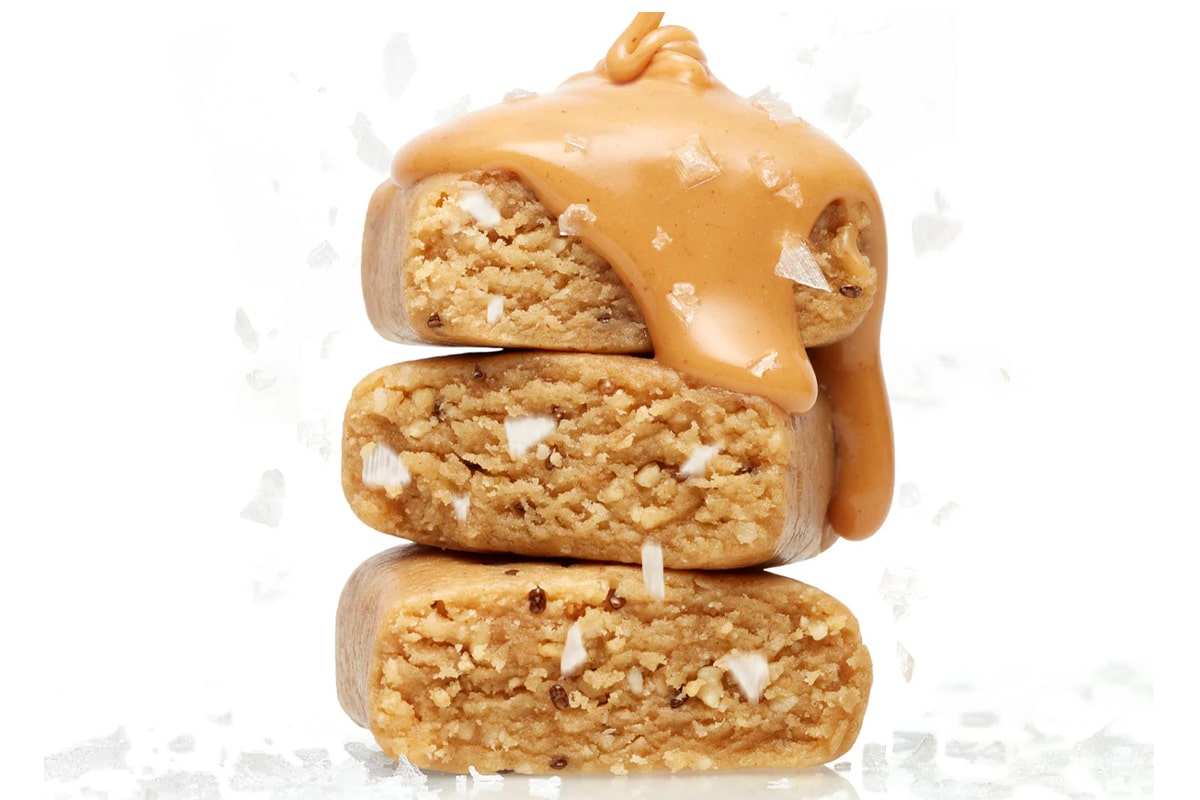
Raw Rev bars are made with organic, plant-based ingredients and packed with fiber, protein, and healthy fats. I love that they skip the fillers and they actually taste good.
I keep one in my bag, my car, and my pantry at all times.
Shop Raw Rev and use code VMANOUSOS at checkout.
Voula’s No-Bake Fiber Bites
When I want something homemade, I whip up a batch of these no-bake bites. Here’s what you’ll need:
- 1 cup rolled oats
- 2 tablespoons chia seeds
- ½ cup almond butter
- ¼ cup dark chocolate chips
- 2 tablespoons honey or maple syrup (optional, depending on your taste)
Mix, roll into balls, refrigerate, and you’ve got a fiber-packed snack that hits all the right notes. They are sweet, satisfying, and no oven required.

Fiber During Pregnancy
Pregnancy is full of surprises, but constipation shouldn’t be one of them. Between iron-rich prenatal vitamins, a growing uterus pressing on your intestines, and hormonal shifts that slow digestion, staying regular can feel like a full-time job. That’s where fiber comes in.
Why Fiber Is Important for Pregnant Women
Pregnant women should aim for at least 28 grams of fiber per day, ideally from whole food sources.
Getting enough fiber during pregnancy plays a major role in:
- Preventing constipation: This one’s obvious, but essential. No pregnant person should be spending half their day in the bathroom trying to “go.”
- Managing blood sugar: Fiber slows the absorption of sugar, helping keep blood glucose levels steady and reducing sugar cravings overall.
- Supporting gut health: A healthy gut microbiome plays a role in immunity, mood, and even how nutrients are absorbed.
- Reducing the risk and severity of hemorrhoids: Less straining means less swelling. Enough said.
Best Fiber-Rich Foods for Pregnancy
Here are a few of my top recommendations for pregnant clients:
- Avocados (about 10 grams per cup): Full of fiber, folate, and healthy fats. Add them to toast, salads, or blend into smoothies.
- Lentils (15 grams per cooked cup): High in both fiber and iron. A great option to support both digestion and blood volume.
- Whole grains like oats, quinoa, and bulgur: These not only deliver fiber but keep you full and energized between meals.
- Berries (about 8 grams per cup of raspberries): Hydrating, antioxidant-rich, and an easy way to sneak in fiber. Add to yogurt, oats, or enjoy on their own.
Want more tailored nutrition support for pregnancy or postpartum? Learn more about my pregnancy and postpartum services here.

Don’t Forget the Water
Fiber only works if you pair it with hydration. Otherwise, it can backfire and make constipation worse.
I tell every pregnant client the same thing: when you increase how much fiber you’re eating, you need to increase your water, too. Try shooting for at least 8–10 cups a day, more if you’re active or dealing with summer heat.
Supporting your digestion during pregnancy helps your body work the way it’s supposed to during a time when everything else feels unpredictable.
Fiber for Colon Health and Daily Function
If you care about your long-term health, your colon deserves some attention. Colon cancer is the third most common cancer in the United States, and diet plays a major role in both prevention and risk. One of the biggest protective factors? Fiber.
High Fiber Foods for Colon Health
A diet high in fiber keeps your digestive system moving, reduces inflammation, and supports the growth of healthy gut bacteria, all of which contribute to a healthier colon.
According to the American Cancer Society, eating more fiber-rich foods, particularly from whole plant sources, can help reduce the risk of colorectal cancer. They recommend at least 25 to 35 grams of fiber per day, coming from a variety of sources.
Here’s what that variety can look like:
- Whole grains like bulgur, oats, and quinoa provide insoluble fiber to help bulk up your stool and move waste through your system.
- Vegetables like broccoli, Brussels sprouts, carrots, and spinach deliver a solid fiber foundation and feed your gut microbiome.
- Fruits, especially those with edible skins or seeds like apples, pears, and berries, offer a mix of soluble and insoluble fiber.
- Seeds and legumes like flax, chia, lentils, and chickpeas help round out your intake with heart-healthy fats and plant-based protein.
Why Variety Matters
No single food provides everything your gut needs. Different fibers feed different types of beneficial bacteria in the gut, so the more variety, the better your digestive and immune systems function over time.
You don’t need to hit perfection every day. But if your meals regularly include fiber from grains, vegetables, fruits, and seeds, you’re doing more for your colon health than any supplement ever could.
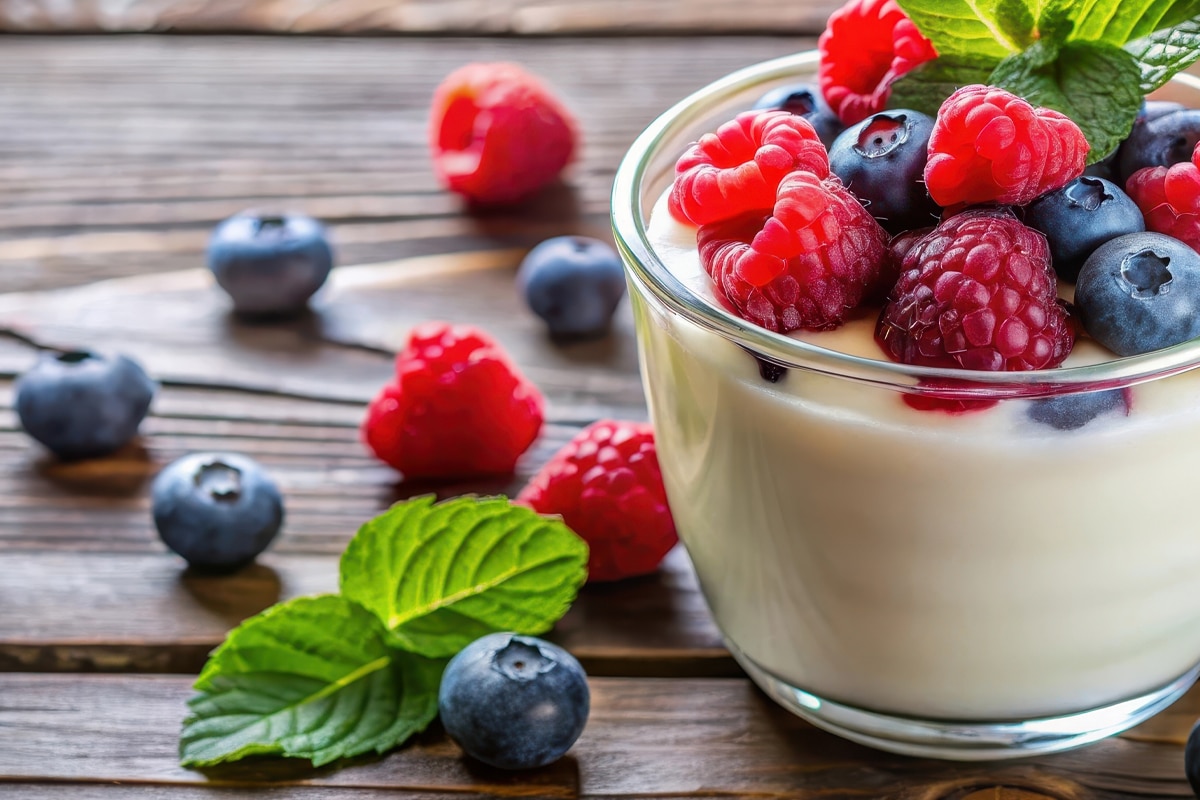
Example of a High Fiber Diet (Sample Day)
What does a full day of fiber-rich eating actually look like and how many grams of fiber does it include? Here’s a simple, satisfying example I often share with clients. It’s balanced, nutrient-dense, and (most importantly) doable.
Breakfast
Oats topped with berries and chia seeds
Start the day strong with a bowl of rolled oats cooked in water or milk of choice. Add a handful of fresh or frozen berries and a tablespoon of chia seeds. This combo provides a mix of soluble and insoluble fiber, plus antioxidants and omega-3s.
Lunch
Bulgur salad with chickpeas and mixed vegetables
Bulgur wheat forms the base, with chickpeas tossed in for protein and fiber. Add chopped cucumbers, tomatoes, parsley, and a lemon-olive oil vinaigrette. This bulgur and chickpea salad easily gives you over 10 grams of fiber per serving. Easy to prep ahead, and holds up well for leftovers.
Snack
Apple slices with almond butter
A fiber-filled snack that also gives you protein and healthy fat to stay satisfied until dinner. Keep the skin on the apple since that’s where most of the fiber lives.
Dinner
Lentil stew with a side salad
A hearty bowl of lentil stew with carrots, celery, garlic, and greens. Pair it with a simple side salad dressed in olive oil and vinegar for a fiber-rich finish.
Dessert
Fresh strawberries with a square of dark chocolate and herbal tea
A sweet way to end the day without a sugar crash. Choose dark chocolate with at least 70% cacao for a little extra fiber and a lot of flavor.
Total fiber for the day? Around 35 grams, give or take. Enough to support digestion, keep you full, and help you feel energized all day.
How to Boost Fiber Without the Bloat
Fiber is amazing for your health, but increasing the amount of fiber you eat too quickly can leave you feeling gassy, bloated, and frustrated.
Here’s how to do it the right way:
Increase Fiber Gradually
Don’t go from 10 grams to 30 grams overnight. That’s a fast track to discomfort. Add one fiber-rich food at a time and give your body a few days to adjust. Start by increasing one meal or snack, then build from there.
Stay Hydrated
Fiber works best when it has water to absorb. Without enough fluid, it can actually make constipation worse. Try to drink 8–10 cups of water per day, and more if you’re pregnant, active, or increasing the amount of fiber in your meals.
Move Your Body
Physical activity helps stimulate your digestive system and keeps things moving.
Even a 10-minute walk after meals can make a difference. I recommend gentle daily movement to all my clients, not just for gut health, but for energy and mood, too.
Upping your fiber doesn’t have to mean digestive drama. Take it slow, drink plenty of water, and keep moving. Your gut will catch up.

Fiber Is Your Friend
Fiber isn’t a punishment. It’s not something you “should” be eating while holding your nose. It’s one of the most underrated tools we have to feel better, from the inside out.
You deserve to feel full without fighting cravings every two hours. You deserve a gut that runs on time. You deserve real energy that doesn’t come from powders, fiber supplements, gummies, or Instagram hype.
Ready to Ditch the Bloat and Feel Good Again?
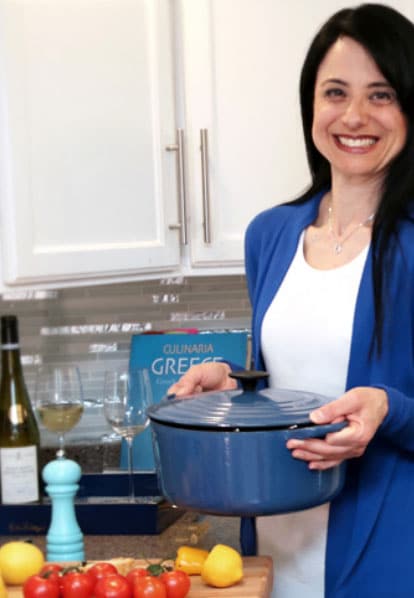
We’ll talk through what’s actually going on, and I’ll help you cut through the noise.
No restrictive plans. No nonsense. Just real food and a plan that works with your life.
Click here to get in touch. Let’s get your gut back on your side.





